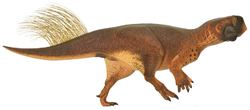| Xenoceratops Temporal range: Late Cretaceous, | |
|---|---|
 | |
| Reconstructed skull | |
| Scientific classification | |
| Kingdom: | Animalia |
| Phylum: | Chordata |
| Class: | Reptilia |
| Clade: | Dinosauria |
| Clade: | † Ornithischia |
| Clade: | † Ceratopsia |
| Family: | † Ceratopsidae |
| Subfamily: | † Centrosaurinae |
| Genus: | † Xenoceratops Ryan, Evans & Shepherd, 2012 |
| Type species | |
| †Xenoceratops foremostensis Ryan, Evans & Shepherd, 2012 | |
Xenoceratops (meaning "alien horned face") is a genus of centrosaurine ceratopsid dinosaur known from the Late Cretaceous (middle Campanian stage), and is known to have lived in what is currently Alberta, Canada. The genus has one known species, Xenoceratops foremostensis, after its place of discovery, the Foremost Formation. [1]






